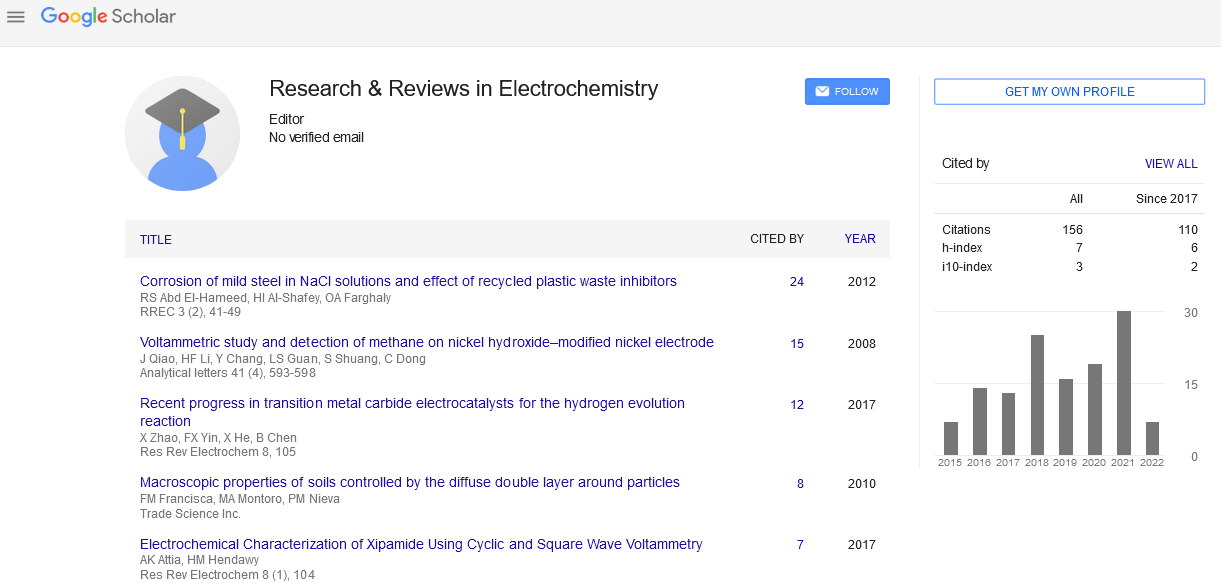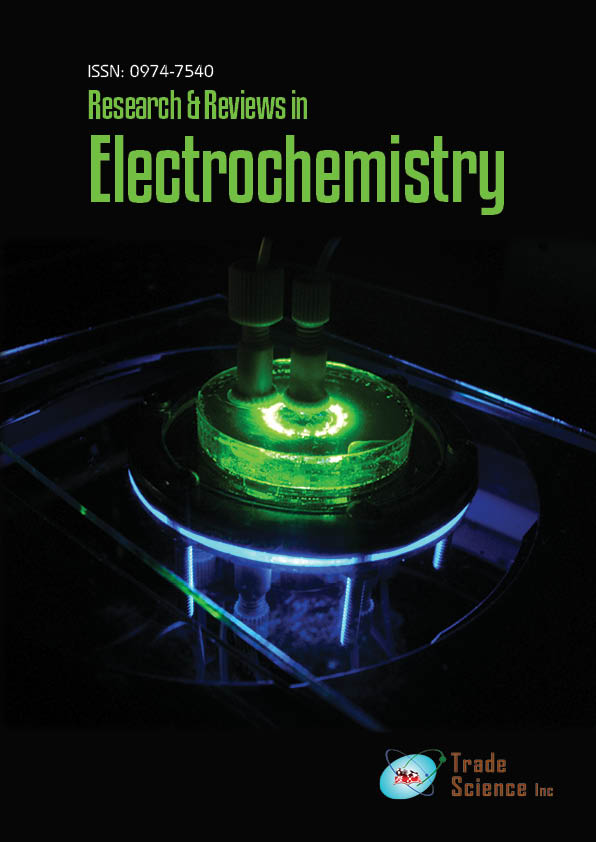Viewpoint
, Volume: 12( 4) DOI: . 10.37532/0974- 7540.22.12.4.248Materials Considerations for Flexible Supercapacitors
- *Correspondence:
- Gary Charles
Editorial Office, Research and Reviews in Electrochemistry, UK
E-mail:electro.med@scholarres.org
Received: 3-July-2022; Manuscript No. tsrre-22-72681; Editor Assigned: 17-July-2022; PreQC No. tsrre-22-72681 (PQ); Reviewed: 23-July2022; QC No. tsrre-22-72681 (Q); Revised: 27-July-2022; Manuscript No. tsrre-22-72681 (R); Published: 29-July-2022, doi no. 10.37532/0974- 7540.22.12.4.248
Citation:Charles G. Materials Considerations for Flexible Supercapacitors. Res Rev Electrochem 2022;12(4):248.
Abstract
Flexible supercapacitors are very appealing for a wide range of emerging portable lightweight consumer devices. The incorporation of a flexible electrode or substrate material to combine structural flexibility with the inherent high power density of supercapacitors is what distinguishes a flexible supercapacitor. Flexible supercapacitors can use either a non-Faradaic energy storage process like the electric double layer capacitor type or a Faradaic mechanism like the Pseudocapacitors (PCs). This review takes into account the most recent advances in pseudocapacitive electrode materials, fabrication techniques, and new materials for electric double layer capacitors, as well as various flexible substrates. Future directions in developing new materials are highlighted in order to improve the enerO7292022gy density and cost-effectiveness of flexible supercapacitors and their use in conjunction with lithium-ion batteries.
Introduction
Flexible energy storage devices are critical to the development of next-generation wearable, compact, and portable electronics for medical, military, and civilian applications, such as flexible displays on phones, health tracking devices, computers, and televisions. To that end, flexible supercapacitors are more appealing than batteries (LIBs) because they combine inherent high power density (>10 kW/kg), fast charging/discharging capability, longer operation lifetime, and mechanical flexibility. Conventional supercapacitors are made up of an outer case, current collectors in the form of metal foils, and positive and negative electrodes in electrolyte separated by an ion transport layer. The highly conducting and flexible carbon network serves as both the electrode and current collector in flexible supercapacitors. As a result, the structural architecture of flexible supercapacitors is lightweight and simplified for use in portable electronics. Another significant difference between flexible supercapacitors and conventional supercapacitors is that each component (e.g., electrodes and packing shell) is flexible. These flexible supercapacitors are typically classified as either Electric Double-Layer Capacitors (EDLCs) or Pseudocapacitors (PCs). To store energy, EDLCs employ the non-Faradaic electrostatic process. They work by accumulating charges at the interface between the electrolyte and the electrode, which is typically made of carbon-based materials with a high specific area. To store charges in PCs, the electrode made of conductive polymers or metal oxides employs a Faradaic mechanism.
Recent advances in supercapacitor materials
Recently, a wide range of new pseudocapacitive electrode materials have been investigated with the goal of increasing the energy density of flexible supercapacitors. PCs have a higher charge storage capacity than EDLCs but are limited by high cost and poor cyclic stability. Nanostructured redox active materials are appealing for PCs because they can increase the active sites for Faradaic redox reactions at the electrode/electrolyte interface for improved charge storage. To that end, a large group of transition metal oxides are known for their promising pseudo capacitive behavior. Historically, several binary metal oxides (e.g., iron oxide, RuO2, NiO, Co3O4, Mo2O3, V2O5, and MnO2) have demonstrated high energy and power density. MnO2 has also shown promise in terms of environmental friendliness, cost-effectiveness, and specific capacitance. However, ternary and higher order metal oxides are particularly appealing because they provide more sites for pseudo capacitive redox processes, allowing for higher capacitance. Because it contains mixed valence metals, the ternary oxide NiCo2O4 is ideal for supporting multiple electrochemical processes. NiCo2O4 nanocrystals grown on various substrates, including carbon fiber paper, nickel foam, and titanium sheets, demonstrated good cyclic stability and capacitance. A highly flexible quasi solid-state supercapacitor device was recently created by sandwiching flower-shaped NiCo2O4 nanocrystal electrodes on Graphene Oxide (GO) substrate. The device demonstrated excellent cyclic stability, indicating that this NiCo2O4-GO electrode material is well suited for the fabrication of variable temperature and high performance flexible supercapacitors. Because of their chemically rich surface area to host redox reactions, transition metal chalcogenides (VS2, CuS, CoE2, NiE2, E = S, Se), rare-earth metal sulphides (La2S3 and Sm2S3), and layer-structured chalcogenides (MoS2 and SnSe) form another class of attractive electrode material for flexible supercapacitors. Due to tremendous advances in wet-chemical synthesis techniques, ternary and higher-order chalcogenide-based materials have recently been successfully synthesised. These materials are also appealing for supercapacitor electrodes because they contain different metal ions, which facilitate rich redox reactions, and the tunable gap between the layers, which can host a wide range of ions from the electrolyte, which increases specific capacitance. CuSbS2 and CuSbSexS2-x mesocrystals, for example, demonstrated exceptional cyclic stability at high current densities, making them suitable for fast charging applications.
Several studies on metal molybdate heterostructures have been conducted because they are cost-effective, environmentally friendly, and exhibit high electrochemical performance. Molybdates with various morphologies and compositions have been studied, including three-dimensional MnMoO4/CoMoO4 heterostructures, CoMoO4-graphene composites, hierarchical NiMoO4 nanospheres, and NiMoO4 nanowires. Because of its high surface area and electrical conductivity, the spherical morphology of NiMoO4 facilitated increased capacitance. The effect of morphology was thoroughly investigated using shape-controlled CoMoO4 nanostructures (e.g., cauliflower, brick-like, and spherical). The material's charge storage capacity is determined by its morphology. The shape-controlled cobalt molybdate electrode-fabricated flexible supercapacitor device demonstrated improved stability as the number of cyclic CV performances increased. The device was also discovered to be a promising candidate for high-temperature supercapacitor applications.

